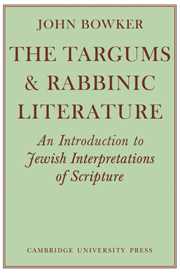Book contents
- Frontmatter
- Contents
- Preface
- Acknowledgements
- Note on the 1979 reprint
- Note on transliteration
- Note on bibliographical references
- List of abbreviations
- INTRODUCTION: THE BACKGROUND OF THE TARGUMS
- 1 Translation and Interpretation
- 2 Pre-Rabbinic Literature
- 3 Non-Rabbinic Literature
- 4 Classical Rabbinic Literature
- PS. JONATHAN ON SELECTED CHAPTERS OF GENESIS
- Appendices
- Bibliography
- Indexes
1 - Translation and Interpretation
Published online by Cambridge University Press: 01 June 2011
- Frontmatter
- Contents
- Preface
- Acknowledgements
- Note on the 1979 reprint
- Note on transliteration
- Note on bibliographical references
- List of abbreviations
- INTRODUCTION: THE BACKGROUND OF THE TARGUMS
- 1 Translation and Interpretation
- 2 Pre-Rabbinic Literature
- 3 Non-Rabbinic Literature
- 4 Classical Rabbinic Literature
- PS. JONATHAN ON SELECTED CHAPTERS OF GENESIS
- Appendices
- Bibliography
- Indexes
Summary
The word targum means in general ‘translation’ or ‘interpretation’, but in particular it is most often used to refer to the Aramaic versions of the Hebrew Bible. The need for such versions arose early: Aramaic was the official language of the Persian empire, and it soon became a ‘common language’ in the Near East; it was not an entirely uniform language, since different areas and ages developed their own dialects. The Jews accepted Aramaic without much difficulty, partly for practical reasons, but also because Aramaic and Hebrew are closely related to each other. The Jews never lost sight of the fact that Hebrew was the language of revelation, and the Scrolls recovered from the Dead Sea area indicate how important Hebrew remained, not least because of its use in legal and other documents; but Aramaic rapidly rivalled it as an ordinary spoken language. As early as the book of Nehemiah there is a lament that Hebrew is inadequately known, and some later parts of the Bible are written in Aramaic.
Understanding of Hebrew was undermined not only by the spread of Aramaic but also by the fact that many Jews, both in the Dispersion and in Palestine, knew Greek and nothing else. Moreover, in the Dispersion there was a constant contact between Jews and non-Jews.
- Type
- Chapter
- Information
- The Targums and Rabbinic LiteratureAn Introduction to Jewish Interpretations of Scripture, pp. 3 - 28Publisher: Cambridge University PressPrint publication year: 1969



